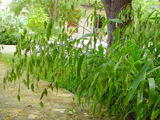Native Plants

Q. Who is Mr. Smarty Plants?
A: There are those who suspect Wildflower Center volunteers are the culpable and capable culprits. Yet, others think staff members play some, albeit small, role. You can torture us with your plant questions, but we will never reveal the Green Guru's secret identity.
Did you know you can access the Native Plant Information Network with your web-enabled smartphone?
Ask Mr. Smarty Plants is a free service provided by the staff and volunteers at the Lady Bird Johnson Wildflower Center.

rate this answer
Thursday - July 01, 2010
From: Tupelo, MS
Region: Southeast
Topic: Rain Gardens, Erosion Control, Grasses or Grass-like
Title: Grasses for moist, steep hillside in Tupelo MS
Answered by: Barbara Medford
QUESTION:
I have a very steep bank that I have pampas grass planted in spots. It must be a natural spring in the bank because it stays very wet and runs into the street below. Can you suggest something to plant that will help with the water runoff and still look good? I was thinking of Louisiana swamp iris. Will this work?ANSWER:
If we may be permitted an editorial comment before we answer your question, Pampas Grass, in our opinion, is a bad choice for landscaping anywhere. It is native to Argentina, and could become the monster that ate Tupelo. See this article Campaign Launched Against Pampas Grass to hear the points against it.
On to the Louisiana Swamp Iris; we had no plant by that common name in our Native Plant Database, but believe it might be Iris fulva (copper iris), which is, indeed, a wetland flower native to both Louisiana and Mississisppi. If there is a low area at the base of the hill and NOT in the street, we would suggest a small rain garden.
Simply put, a rain garden is a depression in the garden that slows down the flow of water, allowing it to infiltrate the soil instead of allowing it to rush downhill carrying topsoil and pollutants with it. The depression is planted with plants that are adapted to conditions alternating between very wet and very dry. You will find a very comprehensive publication about rain gardens, along with instructions and plant lists published by the Clean Water Campaign in Atlanta by following this link. Clean Water Atlanta also has a publication and a suggested plant list.
There are several plants, including the copper iris, that can withstand the sometimes wet, sometimes dry area at the bottom of a drainage area. If the water goes straight from the hillside into the street, we don't think an iris would be very successful, because its roots are rhizomes that sit high in the ground and can be washed away. What you need are fibrous-rooted native grasses (NOT pampas grass) that will hold the soil and help prevent erosion, as well as use the moisture to support themselves. Strictly speaking your Rain Garden would not be to clean stormwater pollutants, but to hold spring water in your soil. We are going to our Native Plant Database and find grasses native to the Lee County area, USDA Hardiness Zone 8a. Follow each plant link to our page on that plant for information on projected size, propagation, light requirements and so forth. Because you are dealing with a slope, you will probably want to put in plugs of the grasses you choose, because seed would likely wash away with the first good rain.
Grasses for Tupelo MS:
Bothriochloa laguroides ssp. torreyana (silver beardgrass)
Carex blanda (eastern woodland sedge)
Chasmanthium latifolium (Inland sea oats)
Elymus virginicus (Virginia wildrye)
Schizachyrium scoparium (little bluestem)
Sorghastrum nutans (Indiangrass)
Tridens flavus (purpletop tridens)
From our Native Plant Image Gallery:
More Erosion Control Questions
Plants for erosion control on steep bank in Ohio
June 10, 2008 - Another erosion question: We bought a place a year and a half ago with a stream/road run off at the back of our property. The southern exposure bank is quite high, I'm guessing 12 feet and therefor...
view the full question and answer
Looking for grasses for slope around retention pond in Florida
August 02, 2011 - I live in St. Petersburg, FL on a large retention pond. Most of my neighbors on the pond have seawalls. I do not nor do my neighbors to my left and right. I am interested in colorful grasses to put...
view the full question and answer
Virginia creeper in trees
April 26, 2008 - Can Virginia creeper be allowed to climb on trees--specifically Texas ash and live oak--or will it damage them if allowed to attach itself? We are thinking of using it as erosion control in a greenbe...
view the full question and answer
Full Sun, Wind-Tolerant Shrubs and Vines for Steep MN Hillside
June 26, 2013 - My neighbor and I share a very steep, large (in total almost 200 ft. wide) west-facing hillside in Excelsior, MN on Lake Minnetonka. We both have a flat grass area at the bottom so the hillside does n...
view the full question and answer
Groundcover for Maryland Slope in Deer Country
July 03, 2016 - I have a 20-30% grade hill in Maryland. I am looking for a groundcover plant (for example ivy) that I can plant on the hill. I have the following issues: clay soil, deer, full sun, limited water sourc...
view the full question and answer
| Support the Wildflower Center by Donating Online or Becoming a Member today. |

